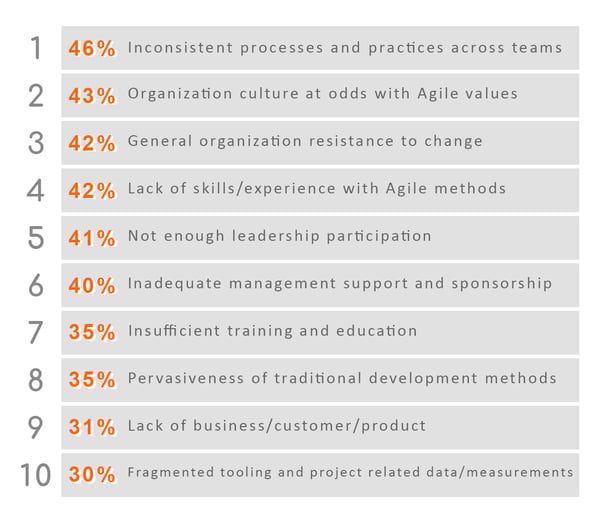
Does your Agile Transformation feel like it is stuck in mud? Maybe it is facing one of the many challenges organizations must navigate as part of their transformation.
According to the 15th State of Agile Report the top 10 Agile Challenges (Digital ai, 2021) are:

The impact of each of these can be detrimental to any Agile Transformation. The report suggests that some organizations face many of these challenges at once. The survey notes that these results have been unchanged over several years. As we look across these top 10, we find most of them relate to the organization’s cultural aspects which means that trying to improve a team’s specific use of an Agile method like Scrum, is less important than trying to improve the overall Agile Culture of the organization.
For a different view into why Agile transformations are challenged, we find the article, How to mess up your agile transformation in seven easy (mis)steps (Handscomb et al., 2018) by a McKinsey team as yet another way to look at the challenges organizations face. The seven missteps are:
- Not having alignment on the aspiration and value of an agile transformation
- Not treating agile as a strategic priority that goes beyond pilots
- Not putting culture first over everything else
- Not investing in the talents of your people
- Not thinking through the pace and strategy for scaling up beyond pilots
- Not having a stable backbone to support agile
- Not infusing experimentation and iteration into the DNA of the organization
If your organization is facing any of these challenges, or you’ve made any of the “missteps” identified by the McKinsey team, your Agile adoption may be at a stall. If you’re experiencing multiple challenges, it may be time to get some help.
When things aren’t going well with your transformation the impacts are felt at the team and organization levels. Next, we’ll look at some of these impacts.
Team Impacts
- Team members feel frustrated and demotivated about working in an Agile environment when they aren’t supported through the transition by managers, each other, and the culture of the organization.
- Team members are unable to deliver quality increments of work due to a lack of consistent processes and tools.
- Team deliveries are hindered by defects.
- Team members struggle to learn and implement new Agile methods, or what they learn does not stick.
- Team members don’t go beyond process and learn delivery practices to improve quality, like TDD, or DevOps.
- Team members don’t work cross-functionally and instead keep silos of expertise.
- Team members struggle to coordinate across teams to remove dependencies.
- Team members burn out due to working at an unsustainable pace.
- Team member turnover is high.
- Stakeholders don’t see the value in their participation with the Team members doing the work, hindering the team’s ability to get real-time feedback and continuously improve.
- Management fails to let the team self-organize taking away from team ownership and accountability for the work. Or even worse, they micro-manage the team, their backlog, or even how they do the work
- Teams find it difficult to release rapidly hampering innovation and increasing time to market.
- Team members aren’t engaged in learning new ways of working.
In addition to the team impacts, there are several organizational impacts that can occur.
Resolving the challenges
In looking at the data, it is imperative that organizations address these challenges head-on. If you’re seeing any of the impacts listed above, you may wonder what to do to alleviate them. One of the biggest mistakes is not incorporating change management as part of an Agile Transformation. Leadership needs to help everyone in the organization understand the new culture underlying how they all work together. It requires leaders and doers alike to learn about Agile values and behaviors. Organizations must invest in training and education at all levels so that learning becomes part of the culture. How do we expect people to become Agile if we don’t teach them what Agile really is?
“What Are the Greatest Contributors to Success When Integrating Change Management and Agile?” According to Tim Creasey (Creasey, n.d.), they are:
- Early engagement of a change manager
- Consistent communication
- Senior leader engagement
- Early wins
Regardless of the Agile Methods you are trying to implement, an organization must start with changing its organizational culture, and the best way to do this is to start with change management. All the efforts of teaching and coaching will fail without the culture change to support the new Agile ways of working. Finally, engage the entire organization, not just IT, in the adoption of Agile practices and behaviors. While a pilot team will help test out a specific Agile method, their work with other members of the organization requires everyone to understand what it means to be Agile. Agile is for everyone, not just IT. A comprehensive change management program will help ensure the entire organization becomes focused on becoming Agile.
Watch for future blogs where we delve into these challenges and what CC Pace can do to help you solve them.
More from the blog
View All Blog PostsSubscribe to Our Blog
Fill out your email address to receive notifications about new blog posts from CC Pace!
